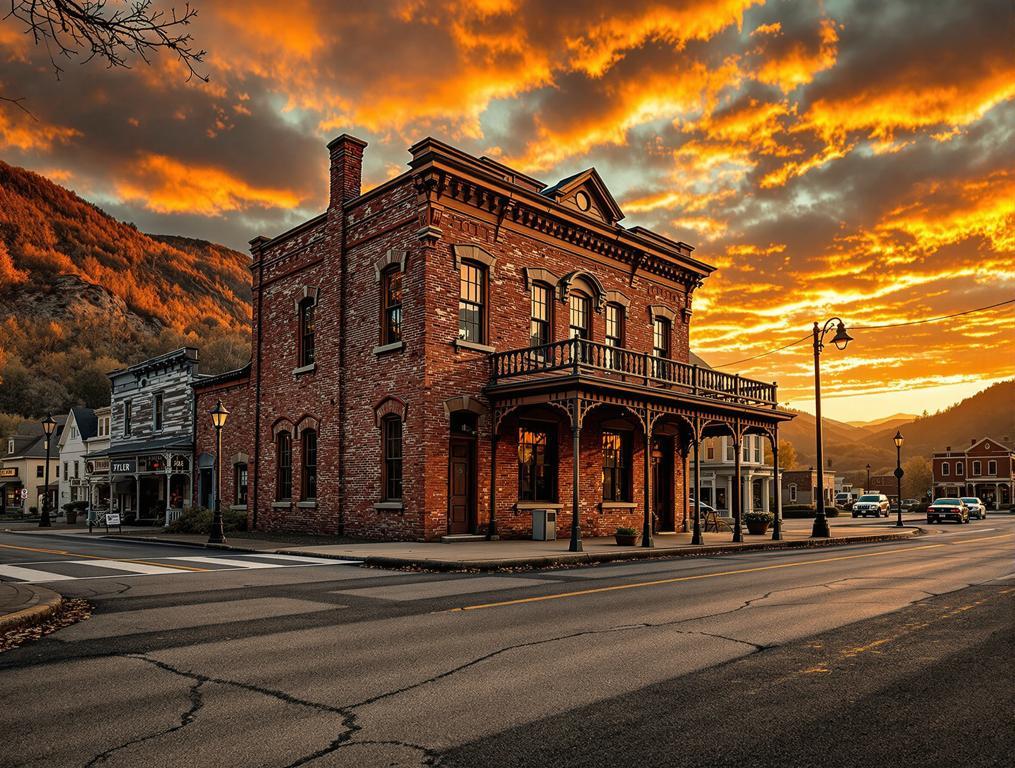I step onto the cracked asphalt of Thurmond’s main street, my footsteps echoing against weathered brick buildings. Not another soul in sight. Just me and the ghosts of what was once West Virginia’s busiest railroad hub. The contrast is jarring – 5 residents maintain more than 50 historic structures in this forgotten coal town, creating America’s most extreme preservation ratio. At 0.1 square miles, this National Historic District sits tucked into a dramatic bend of the New River, just 25 miles southeast of Beckley.
The town feels frozen in amber, as if the last train pulled out yesterday instead of decades ago. While thousands of visitors crowd the nearby New River Gorge Bridge, here I walk completely alone through what feels like a movie set – except every building tells an authentic story.
America’s Most Extreme Ghost Town Ratio: 50 Historic Buildings, Just 5 Residents
Thurmond’s mathematics are staggering. The 10:1 ratio of historic buildings to people creates a preservation density unmatched anywhere in America. Each resident effectively serves as guardian to 10 historic structures – former banks, storefronts, and railroad facilities that once processed coal shipments worth millions in today’s dollars.
Unlike commercialized ghost towns in Colorado or Nevada, Thurmond remains astonishingly authentic. The National Park Service acquired most buildings after the town’s decline, preserving them without the gift shops and costumed interpreters that plague other American ghost towns.
I run my hand along the restored Thurmond Depot’s weathered boards. Built in 1905, this immaculately preserved railroad station now serves as a seasonal visitor center. Inside, black-and-white photographs show the building during its heyday when 15 passenger trains daily served 95,000 travelers annually.
The $1 Million Coal Hub That Time Forgot
Thurmond’s banks once held more coal money than institutions in Cincinnati and Richmond combined. When I venture inside the preserved National Bank of Thurmond building, the original vault still stands – a reminder of when this tiny outpost generated more freight revenue than cities hundreds of times its size.
“I’ve been to historical parks and re-created villages all over America, but this place feels different. Nothing’s been prettied up for tourists. It’s just…real. Like you’re actually walking through 1920.”
Unlike nearby Fayetteville with its boutique shops and adventure tourism infrastructure, Thurmond remains gloriously undeveloped. No traffic lights interrupt the view. No souvenir stands block the historic sightlines. Just the sound of the New River flowing alongside buildings that have stood for over 115 years.
The preservation approach here differs dramatically from other historic building adaptations. Rather than repurposing structures for modern use, Thurmond maintains its original architecture with minimal intervention – a living museum where visitors can explore freely without barriers or crowds.
The Hidden New River Gorge Experience Most Visitors Miss
While thousands flock to overlooks and visitor centers elsewhere in New River Gorge National Park, Thurmond offers a profoundly different experience. The Rend Trail begins at the town’s edge, following an abandoned rail grade with views rivaling those at more popular spots but with a fraction of the visitors.
A 10-minute walk from the depot leads to the Dun Glen Day-Use Area, where you can fish or paddle in solitude while gazing at structures that once housed hundreds of railroad workers. The experience compares favorably to other hidden natural attractions in small American towns.
For a more challenging hike, the Kaymoor Miners Trail connects Thurmond to abandoned mine workings where coal once fueled America’s industrial revolution. In summer, wildflowers dot the trail edges, with peak blooms in July.
Visiting This Time Capsule Before The Secret Gets Out
Reach Thurmond via WV Route 25, a winding single-lane road that drops dramatically into the gorge. The most memorable approach crosses the historic Thurmond Bridge with railroad grates visible beneath your tires. Alternatively, arrive as coal barons once did – Amtrak’s Cardinal Line still stops at Thurmond’s depot three days weekly.
Visit on weekday mornings for the best chance of having the town entirely to yourself. The depot visitor center operates 9am-5pm Thursday through Monday from Memorial Day through Labor Day. Come prepared with downloaded maps as cell service is virtually non-existent in the gorge.
With ongoing development of tourism infrastructure throughout the national park, Thurmond’s days as an undiscovered gem may be numbered. Future plans for heritage tourism innovations could transform this quiet outpost into something more accessible but less authentic.
As I drive away, watching Thurmond shrink in my rearview mirror, I’m struck by how places like this redefine what we mean by “ghost town.” It’s not just abandoned – it’s preserved with care that only a handful of dedicated residents could provide. In a country where history is often reimagined for tourism dollars, Thurmond stands as honestly as the coal miners who once called it home. It’s America’s past, unfiltered and waiting for those willing to venture beyond the crowds.
